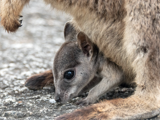If the animal is injured
-
Assess the Situation: Approach the echidna calmly and carefully to assess its condition. Keep in mind that echidnas have sharp spines and can be defensive when injured, so approach from the side or behind where possible.
-
Ensure Safety: If the echidna is in a dangerous location (e.g., near a road), ensure your safety and then move the echidna to a safer area. Use gloves or a towel to handle the echidna to protect yourself and to avoid causing further injury. Throw a towel over the animal and pick it up using both hands on either side of its body. Do not pick it up by its back legs.
-
Containment: If possible, gently lift the injured echidna and place it into a ventilated container such as a sturdy cardboard box or a plastic container with air holes. Line the container with a soft cloth or towel to provide comfort and prevent the echidna from sliding around during transport. If transporting an Echidna in your car make sure it is securely contained in a box. Echidnas are very powerful animals for their size and will easily work their way out of a flimsy box or plastic garbage bag to possibly lodge themselves in an inaccessible part of your vehicle requiring partial dismantling to remove it.
-
Keep Cool and Quiet: Echidnas have a lower body temperature than other animals and are extremely sensitive to heat. They do not need to be kept warm. Heat is a greater danger than cold. In warm, hot weather they should be kept in a cool place. An Echidna which has been hit or run over by a car may show very little evidence of damage as its spiky exterior can mask signs of injury.
- Provide Special Care for Infants: Keep infants (Puggles) in the dark in a moderate temperature. They need highly specialised care involving specially formulated Echidna milk combined with specialised feeding techniques. Contain in a pillow case.
-
Seek Professional Help: Contact a local wildlife rescue organization or your state's wildlife agency as soon as possible. These organizations have the expertise and resources to provide proper medical care and rehabilitation for injured echidnas.
-
Do Not Offer Food or Water: Refrain from offering food or water to the injured echidna. Allow trained wildlife carers to assess its condition properly and provide appropriate care.
-
Transport Carefully: If you need to transport the echidna to a wildlife rescue facility, ensure the container is secure and well-ventilated. Avoid excessive handling or shaking during transport to minimize stress and further injury to the echidna.
-
Follow Advice: Follow any advice or instructions given by the wildlife rescue organization or rehabilitator. They may provide further guidance on caring for the echidna or transport instructions if you need to take it to them directly.
If the animal is dead
-
Handle with Care: Use gloves or a plastic bag to handle the echidna to minimize direct contact. Echidnas, like other wildlife, can carry diseases, and handling them without protection can pose health risks.
-
Document and Identify: If possible and safe to do so, take note of the location where the echidna was found and any visible characteristics that might help identify the species. This information can be helpful if you decide to report the finding to authorities.
-
Dispose Properly: Place the dead echidna in a sealed plastic bag and then dispose of it in your household waste bin. Do not bury it or leave it exposed, as this could attract scavengers or spread disease.
-
Report to Authorities (Optional): While it's not always necessary, you can report the finding to local authorities such as the local council, state wildlife agency, or a wildlife rescue organization. They may be interested in monitoring local echidna populations or investigating potential threats to their health.
-
Personal Hygiene: After handling the echidna or disposing of it, wash your hands thoroughly with soap and water to reduce the risk of any potential contamination.
-
Observe for Other Wildlife: Keep an eye out for other sick or injured wildlife in the area. If you notice a pattern of deaths among wildlife, especially if it seems unusual or widespread, reporting it to authorities may be important for investigation and conservation efforts.

Be a Wildlife Hero
Make a difference today by supporting Kanyana Wildlife.
Join us in safeguarding Australia's precious wildlife through rescue, rehabilitation, and habitat protection.
Your support powers our mission and your generosity directly impacts the lives of injured, orphaned, and displaced animals in need. Together, we can make a lasting impact on wildlife conservation right here in Western Australia.
Whether you donate, volunteer, or adopt, you're making a difference.

